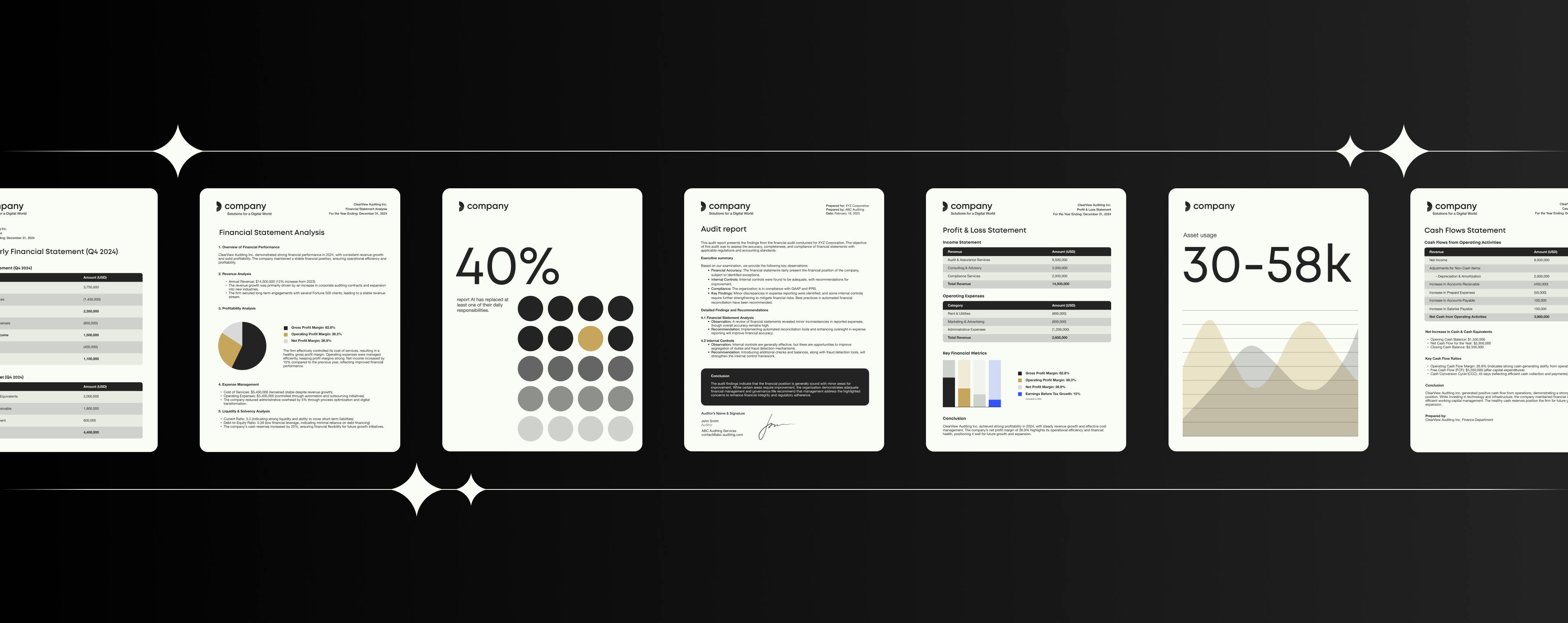7 use cases to start document automation in your organization

Document automation is the way to keep up in a fast-moving business environment, and it’s changing the game for creating and managing documents.
No more endless hours spent on tweaking Word templates or sprucing up PowerPoint slides. Automated document generation is doing those tedious tasks quicker and more precisely.
Just think about the marketing and sales departments. They need to be able to keep pace with the market and roll out updated presentations and proposals on the fly. And for legal documents as well – they must be spot-on all the time.
Automating them makes sure you’re always hitting the mark. Document automation is about turning the document creation process into a powerhouse of innovation and forward momentum.
Read on to discover the seven most common use cases where Templafy’s document automation solutions deliver tangible results.
Key benefits of document automation
With the right system in place, your team can create documents in a fraction of the time. The hours saved translate directly into costs cut, not to mention the bump in productivity. Teams can focus on the work that matters – building relationships, brainstorming strategies, and steering the business forward.
But here’s the kicker: reducing costs isn’t only about shaving hours off document creation. It’s also about eliminating mistakes that can lead to bigger problems down the line. Fewer errors mean fewer revisions, less compliance risk, and a smoother ride for everyone involved.
In a nutshell, document automation helps you do more for less, and who doesn’t want that?
Templafy’s AI Assistant
Unlock the power of AI without the risks
#1: Marketing collaterals and communications
When your brand’s story is out there, you want it to shine, not get lost in translation with outdated figures or last year’s tagline. Marketing teams feel the heat when they’re drowning in requests for fresh collateral, all while trying to keep every piece on-brand and up-to-date.
Document automation ensures that every sales sheet, brochure, and email banner is current. It automates the grunt work, syncing with CRM tools like Salesforce to keep content fresh and on-point.
Suddenly, your team’s got more time for creativity and strategy, and the branding police can take a breather. Everyone’s using the right stuff, and your brand stays as polished as it should be.
#2: Sales proposals
According to the latest ‘Sales State report’ by Salesforce, sales reps spend less than 30% of their time selling. Instead, they often find themselves deep in the weeds of document formatting when they should be out there forging relationships.
Every minute spent on aligning text boxes in a presentation is a minute not spent with a client. Plus, there’s always that nagging fear of missing the latest data or figures, which could mean the difference between closing a deal or not.
Templafy, with its Library and Dynamics capabilities, automatically creates documentation based on gating questions and information, pulling in the most recent data and aligning with the necessary guidelines without a hitch.
For Sales teams, Salesforce has been instrumental in centralizing key information and workflows. When used in tandem with Templafy’s automated document generation capabilities, teams can firmly establish Salesforce as their central post of command in the digital HQ, making sure that every proposal is a home run in both content and design.
Ready to power up your proposals?
Download our comprehensive guide for an in-depth exploration of these factors and more.
#3: Contracts and legal documents
Lawyers and legal professionals are all too familiar with the tedium of drafting and revising contracts. Every clause and provision must be precise, and personalizing these documents can devour hours, if not days. It’s a meticulous process where the cost of error is high, and the workload is relentless. Beyond the drafting, there’s the circuit of approvals and revisions, often bottlenecked by the availability of key stakeholders.
According to Thomson Reuters, lawyers experience up to 82%-time savings when using document automation to generate contracts and other legal documents. By automating the assembly of contracts and other legal documents, it ensures that the latest legal standards are always met, with the added benefit of streamlining the approval process.
Integrations with platforms like SharePoint can trigger workflows for review and approval directly within the tools legal teams use daily, like Microsoft Teams or Slack. The result? Faster turnaround, fewer errors, and a legal team that can focus on substantive work rather than paperwork.
#4: Compliance and regulatory documents
For any business operating in a regulated industry, getting compliance documents right isn’t just important – it’s everything. A single oversight can lead to significant compliance issues, making this a high-stakes task that’s prone to human error.
Document automation acts as a meticulous gatekeeper, automating the flow of updated information into your compliance documents. Templafy keeps these documents compliant, and current, across the board with real-time data integration.
With Templafy’s platform, managing and distributing essential document assets across your organization becomes effortless. This includes everything from document and presentation templates to text elements, images, graphs, ready-made slides, PDFs, and spreadsheets.
#5: HR documents and employee onboarding
HR departments are tasked with generating a vast array of documents, from offer letters to performance evaluations, all while navigating a workplace where, according to one study, the average employee switches tasks every three minutes and five seconds.
In such a dynamic environment, the manual creation of documents becomes a significant drain on resources, underscoring the need for more efficient processes.
Document automation allows HR teams to automate the creation and distribution of personalized documents directly from their ATS (Applicant Tracking System). With Templafy, once the approvals are in place, contracts and other onboarding documents can be sent out automatically, ensuring a smooth start for new hires and a more strategic use of HR’s time.
Check out how Templafy boosts HR efficiency.
#6: Academic and educational materials
For administrators and educators alike, maintaining a repository of current, branded, and accurate documents is a challenge, especially across large institutions. The result is often a compromise on either the quality or timeliness of educational content.
Document automation with Templafy helps educational institutions stay ahead of the curve. By centralizing content distribution and ensuring consistent branding, Templafy empowers educators and staff to focus on delivering quality education rather than on document management.
Aarhus University’s leap towards digital transformation with Templafy is a prime example of enhancing brand consistency and governance in the academic sector.
#7: Insurance policies
In the post-pandemic era, many insurers are rethinking how they can manage and send critical customer communications including renewals, declarations, endorsements, policy documents, notices, and more.
Additionally, according to the 2023 DBIR by Verizon, data breaches remain a significant threat to the industry. Their research found 1,832 incidents of which 480 included confirmed data disclosure. Manual document processes not only increase the risk of errors but also expose sensitive personal information to potential threats.
Templafy’s approach to document automation in the insurance sector addresses these challenges head-on. By automating the generation of policy documents, insurers can reduce operational expenses, minimize the risk of data exposure, and comply with data privacy laws.
Templafy ensures that critical communications are accurate, up-to-date, and secure, reflecting the latest industry standards and protecting customer information.
Get started with Templafy
Our platform directly addresses the everyday bottlenecks of document creation: the time drain of manual data entry, the risk of outdated content, and the complexities of maintaining brand and legal compliance across global teams.
With Templafy, these pain points are systematically eliminated through intelligent automation that integrates seamlessly with your existing tech stack. It simplifies the creation of on-brand, compliant documents, ensuring that your team’s output is as professional and current as your brand promises.
Ready to see these use cases in action and experience the impact firsthand? Schedule a demo today and see how our document automation solutions can safeguard your brand and ensure compliance with ease.



